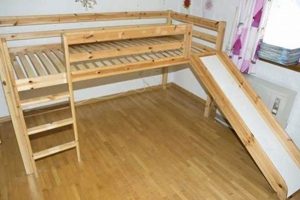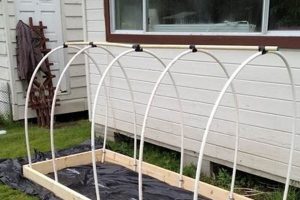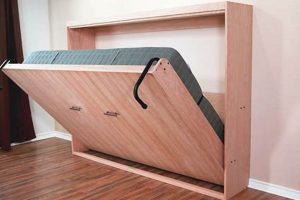A self-assembled sleep system utilizing latex foam components allows for a high degree of customization. This approach involves selecting and combining layers of latex, typically in varying densities and thicknesses, to achieve a desired level of support and comfort. For instance, an individual might choose a firm latex core for spinal alignment, topped with softer layers for pressure relief.
The advantages of this custom construction method include personalized firmness, potential cost savings compared to pre-built mattresses, and the ability to tailor the bed to specific physical needs. Historically, mattress construction was a more hands-on endeavor, and this method represents a return to a personalized approach, leveraging modern materials. Furthermore, component replacement addresses longevity concerns, as individual layers can be exchanged as needed without replacing the entire sleep surface.
The subsequent discussion will delve into the considerations involved in selecting latex types, assessing layer configurations, and understanding the factors that contribute to a successful sleep surface construction. Detailed explanations of each element will provide comprehensive guidelines for the assembly process.
Essential Considerations for Latex Sleep Surface Construction
The following guidelines are crucial for ensuring a successful outcome when building a custom latex sleep surface. Careful planning and material selection are paramount.
Tip 1: Assess Individual Support Needs: Before selecting any materials, thoroughly evaluate individual sleep preferences, body weight, and any existing musculoskeletal conditions. This assessment will inform the selection of latex densities and layer arrangements.
Tip 2: Research Latex Types: Differentiate between Dunlop and Talalay latex. Dunlop is denser and generally firmer, while Talalay is more breathable and offers a softer feel. Understand the properties of each type to determine the best fit for each layer.
Tip 3: Plan Layer Configuration: Design the layer arrangement strategically. Typically, a firmer core provides support, followed by progressively softer layers for comfort and pressure relief. Consider a zoned support system for targeted spinal alignment.
Tip 4: Invest in High-Quality Materials: Source certified organic or natural latex from reputable suppliers. Lower-quality latex may contain synthetic fillers or undergo processes that compromise its durability and breathability. Independent certifications can verify the latex composition.
Tip 5: Consider a Breathable Cover: Encasing the latex layers in a breathable cover, such as organic cotton or wool, promotes airflow and regulates temperature. This reduces heat buildup and enhances overall sleep comfort.
Tip 6: Test Layer Combinations: Before finalizing the construction, test different layer combinations to fine-tune the firmness and support. Experiment with layer placement to optimize the feel of the sleep surface.
Tip 7: Factor in Total Thickness: Account for the total thickness of the mattress when selecting bedding and ensuring proper bed frame support. An excessively thick mattress may require specialized bed frames.
Adhering to these tips optimizes comfort, support, and the overall lifespan of the custom sleep surface. Informed decision-making throughout the construction process leads to a personalized and effective sleep solution.
The subsequent sections will provide guidance on ongoing maintenance and troubleshooting potential issues that may arise after the construction is complete.
1. Material Density
Material density is a critical factor in the construction of a self-assembled latex sleep system. It directly influences the firmness, support, and overall feel of the finished mattress. Selecting appropriate densities for each layer is essential for achieving the desired level of comfort and ergonomic alignment.
- Core Support Layer
The density of the core layer dictates the primary level of support. Higher density latex, typically in the range of 75-85 kg/m, provides firm support, crucial for maintaining spinal alignment, especially for back and stomach sleepers. An insufficient core density results in sagging and compromised support, potentially leading to discomfort or pain.
- Transition Layers
Transition layers, positioned between the core and comfort layers, bridge the gap in firmness. Medium-density latex (65-75 kg/m) in these layers facilitates a smoother transition, preventing abrupt changes in feel. This ensures pressure is distributed evenly across the surface, reducing the likelihood of pressure points.
- Comfort Layers
The uppermost comfort layers prioritize pressure relief. Lower density latex (55-65 kg/m) provides a softer feel, conforming to the body’s contours. This is particularly important for side sleepers who require cushioning at the shoulders and hips. Overly dense comfort layers negate the pressure-relieving benefits, leading to a feeling of sleeping “on top” of the mattress rather than “in” it.
- Zoned Support Implications
Incorporating varying densities within the same layer allows for zoned support. For example, a core layer might feature a higher density in the lumbar region to provide enhanced support for the lower back. This targeted approach addresses specific areas of the body that require additional support, improving overall spinal alignment and comfort. Failure to consider zoned density can lead to uneven support and potential discomfort.
The strategic use of material density is paramount in constructing a custom sleep surface. Balancing support and comfort requires a thorough understanding of the properties of varying latex densities and their impact on the overall feel of the sleep system. Precise selection and layering directly influence the effectiveness and long-term satisfaction with the DIY mattress.
2. Layer Configuration
In the context of a self-assembled latex sleep system, layer configuration directly dictates the overall firmness, support characteristics, and pressure relief capabilities of the finished product. The order and composition of latex layers represent a critical design element, influencing the ergonomic properties and suitability of the mattress for individual needs. A poorly conceived configuration can negate the inherent benefits of latex, resulting in inadequate support, discomfort, or premature material degradation. Conversely, a well-planned configuration optimizes comfort and extends the lifespan of the sleep surface.
Consider, for example, a scenario where a soft latex layer is positioned directly beneath a very firm layer. This configuration leads to a “hammocking” effect, where the body sinks excessively into the softer layer without adequate support from below, potentially exacerbating spinal misalignment. A more effective configuration would involve a gradual transition in firmness, with progressively softer layers building upon a firm core. This approach ensures that support is distributed evenly and that pressure points are adequately cushioned. Further, consideration must be given to the individual’s sleep position. Side sleepers, for instance, typically benefit from thicker, softer comfort layers to accommodate the shoulders and hips, whereas back sleepers generally require a firmer, more supportive core.
Therefore, the strategic arrangement of layers within a latex sleep surface is paramount. Understanding the properties of each layer, anticipating the combined effect, and tailoring the configuration to specific needs directly contributes to a sleep experience that is both comfortable and ergonomically sound. This necessitates a thorough evaluation of individual sleep preferences and a deliberate approach to material selection and arrangement. Ignoring the intricacies of layer configuration undermines the potential benefits and reduces the overall value.
3. Support Zones
Support zones represent a critical design element in the construction of a customizable latex sleep surface. These zones are engineered to provide differentiated levels of firmness and support to specific areas of the body, addressing variations in weight distribution and pressure points. The implementation of support zones is intended to enhance spinal alignment and improve overall sleep comfort.
- Lumbar Support
The lumbar region often requires enhanced support due to its natural curvature and the concentration of body weight. Within a latex mattress, this can be achieved through the inclusion of a higher density latex layer or the incorporation of specialized foam inserts in the central third of the mattress. Insufficient lumbar support can lead to lower back pain and compromised spinal alignment.
- Shoulder and Hip Zones
Side sleepers place increased pressure on the shoulders and hips. Support zones in these areas typically utilize softer latex densities or convoluted foam designs to allow for greater compression and pressure relief. This prevents the formation of pressure points and promotes healthy spinal alignment. Neglecting these zones may result in discomfort and restricted circulation.
- Edge Support
Reinforced edge support is crucial for maintaining the structural integrity of the mattress and preventing sagging along the perimeter. This is often achieved through the inclusion of higher density latex or the use of reinforced coils along the edges. Adequate edge support provides a stable sleep surface and facilitates ease of entry and exit from the bed.
- Transitional Zones
Effective support zone integration requires smooth transitions between areas of varying firmness. Abrupt changes in support can create pressure points and disrupt sleep. Transitional zones utilize intermediate density latex to ensure a gradual shift in support levels, promoting a more comfortable and seamless sleep experience.
The strategic implementation of support zones within a custom-built latex sleep system allows for a highly personalized sleep experience. By tailoring the support characteristics of specific areas of the mattress, individuals can optimize spinal alignment, minimize pressure points, and enhance overall sleep quality. A comprehensive understanding of support zone principles is essential for maximizing the ergonomic benefits of a do-it-yourself latex mattress construction.
4. Breathability Factors
Breathability, in the context of a self-assembled latex sleep system, is a critical performance characteristic influencing temperature regulation, hygiene, and overall sleep comfort. The inherent properties of latex, coupled with construction techniques, determine the extent to which air can circulate through the mattress, dissipating heat and moisture. Insufficient breathability results in heat retention, elevated humidity levels within the sleep environment, and potentially, the proliferation of allergens and microorganisms. A direct consequence is disrupted sleep, as the body struggles to maintain a comfortable core temperature. For example, a latex mattress constructed with dense, tightly packed layers and a non-breathable cover will inevitably trap heat, leading to discomfort and potentially night sweats. Conversely, a mattress utilizing open-cell latex, strategically spaced layers, and a breathable cover material, such as organic cotton or wool, promotes airflow, maintaining a cooler and drier sleep environment.
The choice of latex type, Dunlop or Talalay, significantly affects breathability. Talalay latex, manufactured through a process that creates a more open-cell structure, generally exhibits superior airflow compared to Dunlop. However, even with Talalay latex, careful consideration must be given to the cover material and the overall layer configuration. Dense, synthetic covers restrict airflow, negating the breathability benefits of the latex itself. Similarly, tightly packed layers can impede air circulation, regardless of the latex type. Real-world examples highlight the tangible impact of breathability factors; individuals residing in warmer climates or those prone to night sweats frequently report improved sleep quality when utilizing latex mattresses specifically designed for optimal airflow.
Effective management of breathability in a customized latex sleep surface is thus paramount. Prioritizing open-cell latex, utilizing breathable cover materials, and employing strategic layer spacing contribute to a sleep environment that promotes temperature regulation and hygiene. Failure to address these factors can compromise the comfort, longevity, and healthfulness of the mattress. This underscores the importance of informed material selection and careful construction techniques to maximize the potential benefits of a self-assembled latex sleep system.
5. Component Longevity
Component longevity, a crucial factor in the long-term value proposition of a self-assembled latex sleep surface, directly affects the cost-effectiveness and sustainability of the system. Unlike conventionally manufactured mattresses, the modular nature of this approach allows for the replacement of individual components, extending the lifespan of the overall sleep system. The durability of each layer, therefore, assumes paramount importance in evaluating the long-term viability of this construction method.
- Latex Quality and Degradation
The grade and processing of the latex core directly impacts its resistance to degradation. Natural latex, as opposed to synthetic blends, generally exhibits superior durability and resilience against compression set. Exposure to ultraviolet light and humidity accelerates latex degradation, leading to a loss of firmness and support. Consequently, sourcing high-quality, certified natural latex is critical for maximizing the lifespan of the core layers. Instances of premature sagging in DIY mattresses often correlate with the use of lower-grade latex or inadequate protection from environmental factors.
- Cover Material Durability
The cover material serves as a protective barrier against wear and tear, moisture, and allergens. Durable, tightly woven fabrics, such as organic cotton or wool, offer enhanced protection and resist pilling and tearing. Synthetic covers, while potentially more cost-effective, often exhibit reduced breathability and may degrade more rapidly. A compromised cover material can expose the latex layers to environmental factors, accelerating degradation and reducing overall system longevity.
- Layer Interface Integrity
The interfaces between individual latex layers are points of potential stress and wear. The relative movement between layers during sleep can lead to friction and compression, gradually compromising the structural integrity of the interface. Securing the layers with a breathable adhesive or encasing them within a tightly fitted cover minimizes movement and reduces wear. Neglecting layer interface integrity can result in uneven wear patterns and localized sagging, diminishing the overall comfort and support of the mattress.
- Foundation Support Influence
The type of foundation supporting the latex mattress significantly impacts its longevity. A solid, flat platform provides uniform support, distributing weight evenly and preventing localized stress on the latex layers. Slatted foundations, while offering enhanced breathability, require appropriately spaced and sufficiently strong slats to prevent sagging. Inadequate foundation support leads to uneven weight distribution, accelerating wear and tear on the latex layers and reducing the lifespan of the entire sleep system.
The long-term performance of a self-assembled latex sleep surface hinges on a holistic consideration of component longevity. Selection of high-quality materials, meticulous construction techniques, and appropriate foundation support synergistically contribute to a durable and sustainable sleep solution. Furthermore, routine maintenance, such as rotating the mattress and protecting it from environmental factors, extends the lifespan of the individual components and maximizes the overall value of the DIY system. Failure to address these factors compromises the initial investment and negates the long-term cost advantages associated with component replacement.
Frequently Asked Questions
The following frequently asked questions address common concerns and misconceptions regarding the assembly and utilization of a personalized sleep system constructed from latex components. These answers provide factual information to aid in informed decision-making.
Question 1: What is the expected lifespan of a self-assembled latex sleep surface?
The longevity of a custom-built latex mattress depends on the quality of the materials and maintenance practices. High-quality natural latex can last 10-15 years or more. However, synthetic blends typically exhibit a shorter lifespan. Proper support and regular rotation contribute to extended usability.
Question 2: How does the firmness of Dunlop latex differ from Talalay latex?
Dunlop latex generally possesses a firmer and denser structure than Talalay latex. The manufacturing process results in a more uniform cell structure in Dunlop, leading to greater support. Talalay, with its more open cell structure, offers a softer and more conforming feel.
Question 3: Is a specialized bed frame required for a latex mattress?
A specialized bed frame is not strictly required, but adequate support is essential. A solid platform or a slatted foundation with closely spaced, robust slats is recommended. Inadequate support can lead to sagging and premature wear of the latex components.
Question 4: What are the health considerations associated with latex mattresses?
Natural latex is generally considered hypoallergenic and resistant to dust mites and mold. However, individuals with latex allergies should exercise caution. Certified natural latex mattresses are often free from harmful chemicals and volatile organic compounds (VOCs).
Question 5: How can off-gassing from latex be minimized?
Off-gassing is primarily associated with synthetic latex blends and adhesives. Selecting certified natural latex and allowing adequate ventilation during the initial setup period can minimize potential odors. Any residual odor typically dissipates within a few days.
Question 6: What is the recommended layer configuration for a side sleeper?
A side sleeper typically benefits from a softer comfort layer to accommodate the shoulders and hips, coupled with a supportive core to maintain spinal alignment. A common configuration includes a firm latex core, a medium transition layer, and a soft comfort layer.
The provided answers offer insights into critical aspects of latex mattress construction. Individual research and assessment remain essential for optimizing the sleep experience.
The subsequent section provides details on the tools required for assembly and best practices during the construction phase.
DIY Latex Bed
This exploration has elucidated the multifaceted considerations involved in constructing a customized sleep system utilizing latex components. Key elements, including material density, layer configuration, support zones, and breathability factors, directly impact the comfort, support, and longevity of the resultant sleep surface. Proper execution necessitates informed material selection, meticulous planning, and adherence to established construction techniques. The potential benefits, encompassing personalized support, cost-effectiveness, and component replaceability, are contingent upon diligent application of these principles.
The pursuit of a customized sleep solution through the construction of a diy latex bed demands careful consideration and a commitment to informed decision-making. The principles outlined herein provide a foundational framework for maximizing the potential benefits of this approach. Continued research and critical evaluation of individual needs are paramount to achieving a sleep environment that promotes both physical well-being and long-term satisfaction.







